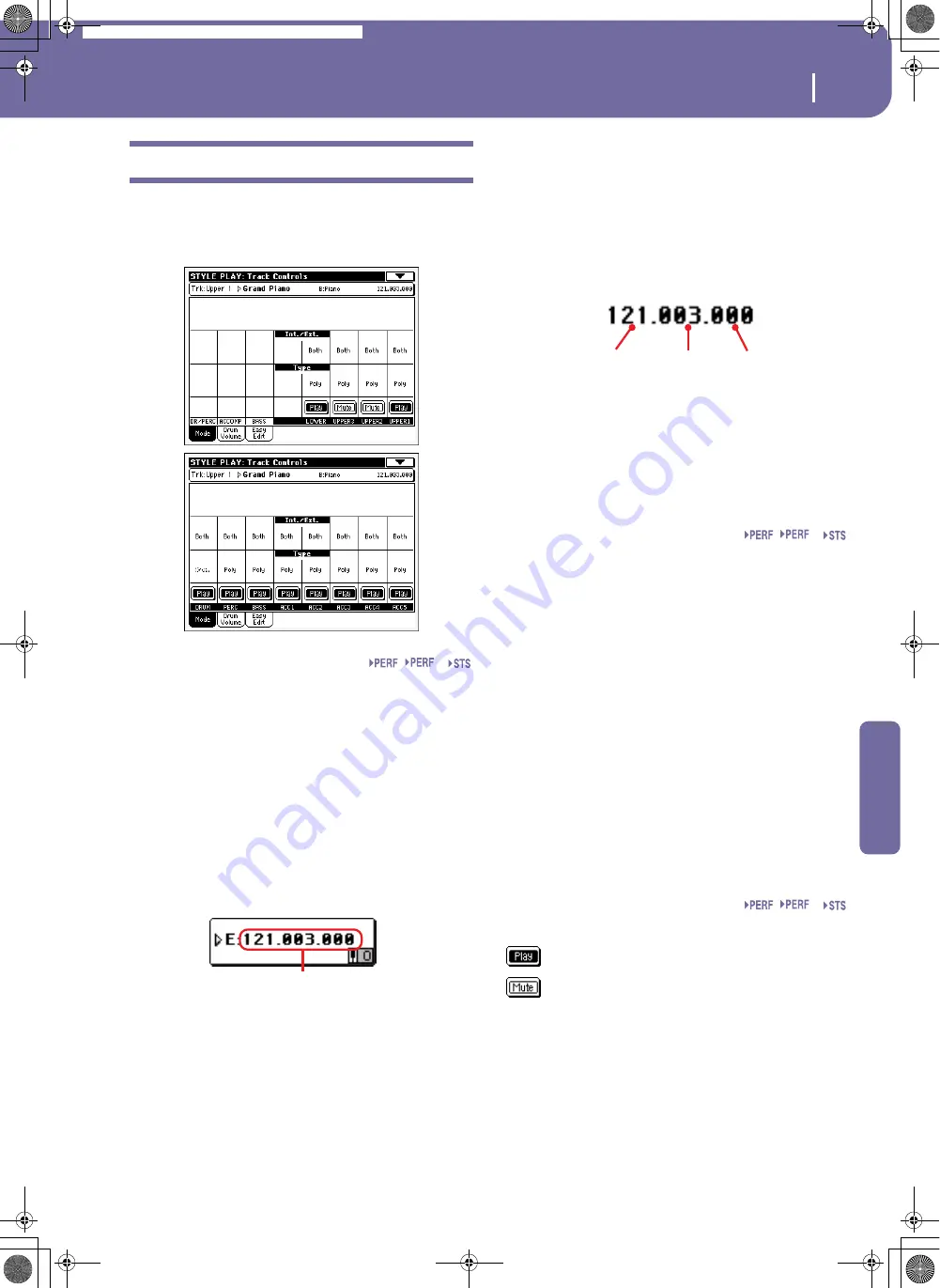
93
Style Play operating mode
Track Controls: Mode
Reference
Track Controls: Mode
This page lets you connect each track to the internal sound gen-
erator and to external MIDI devices. This is very useful to let one
of Pa588’s track drive an external expander. In addition, here you
can set the polyphony mode for each track.
Int./Ext. (Internal/External)
Internal
The track plays the sounds generated by the
internal sound engine. It does not play an exter-
nal instrument connected to the MIDI OUT.
External
The track plays an external instrument connected
to the MIDI OUT. The connected device must
receive on the MIDI channel associated with this
track on the Pa588 (see “MIDI: MIDI Out Chan-
nels” on page 209).
A track set to this status does not play the internal
sounds, therefore saving polyphony.
Instead of the assigned Sound name, the
<E: aaa.bbb.ccc>
indicator is shown on a track’s
area in the Main page:
This indicator begins with a remark saying the
track is in External (”E”) mode, and continues
with a strings of transmitted Control Change and
Program Change data. This will let you know
what the track is transmitting to the MIDI OUT.
In the following example,
CC#0
is the Control
Change 0 (Bank Select MSB),
CC#32
is the Con-
trol Change 32 (Bank Select LSB),
PC
is the Pro-
gram Change:
When touching the Sound area, the numeric key-
pad appears, instead of the Sound Select window.
You can enter the Control Change/Program
Change bundle shown above, separating the three
parts with a dot (.).
Both
The track plays both the internal sounds and an
external instrument connected to the MIDI OUT.
Type
Drum
Drum/Percussion track. Set a track to Drum
mode if you wish to separately adjust the volume
of each percussive family of the assigned Drum
Kit Sound. (See “Track Controls: Drum Volume”
on page 94).
Note:
Tracks set to Drum or Percussion mode while
in Style Record (see “Track Type” on page 126),
cannot be edited here. This option appears in grey.
Other Style tracks cannot be set to Drum mode
here.
Poly
Tracks of this kind are polyphonic, i.e. they can
play more than one note at the same time.
Mono
Tracks of this kind are monophonic, i.e. each new
note stops the previous note.
Mono Right
A Mono track, but with priority assigned to the
rightmost (highest) note.
Mono Left
A Mono track, but with priority assigned to the
leftmost (lowest) note.
Play/Mute icon
Track’s play/mute status.
Play status. The track can be heard.
Mute status. The track cannot be heard.
Sty
Control Change/Program Change area
CC#0 value
CC#32 value
PC value
Sty
Sty
Pa588-100UM-ENG.book Page 93 Monday, May 26, 2008 4:34 PM
Summary of Contents for Pa588
Page 1: ...User s Manual ENGLISH OS Ver 1 0 1 E ...
Page 8: ...4 Table of Contents Pa588 100UM ENG book Page 4 Monday May 26 2008 4 34 PM ...
Page 9: ...Introduction Pa588 100UM ENG book Page 5 Monday May 26 2008 4 34 PM ...
Page 34: ...30 Interface basics Shortcuts Pa588 100UM ENG book Page 30 Monday May 26 2008 4 34 PM ...
Page 35: ...Quick Guide Pa588 100UM ENG book Page 31 Monday May 26 2008 4 34 PM ...
Page 79: ...Reference Pa588 100UM ENG book Page 75 Monday May 26 2008 4 34 PM ...
Page 239: ...Appendix Pa588 100UM ENG book Page 235 Monday May 26 2008 4 34 PM ...
Page 251: ...Pa588 100UM ENG book Page 247 Monday May 26 2008 4 34 PM ...






























